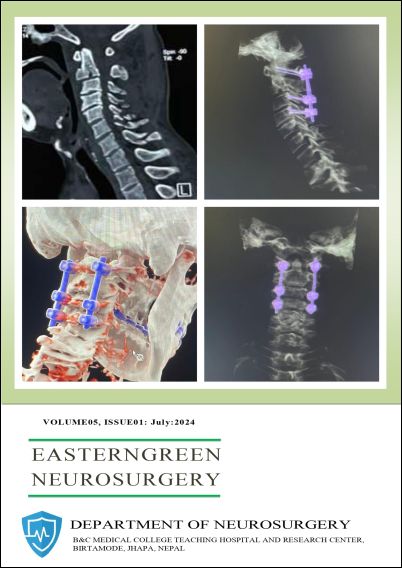Intracranial Empyemas: Experience of the Neurosurgery Department of Conakry University Hospital
DOI:
https://doi.org/10.3126/egn.v5i01.68446Keywords:
Antibiotic Therapy, Empyema, Extradural, Neurosurgery, SubduralAbstract
Introduction: Intracranial empyemas are rare intracranial suppurations but carry serious and potentially fatal prognosis In the absence of adequate treatment. The objective of our study was to determine the epidemiological, clinical features, therapeutic and evolutionary characteristics of these suppurations in our department. Materials and methods: It was a descriptive retrospective study of 88 intracranial empyemas files collected over a period of 5 years (January 2014-December 2018) in the archives of the neurosurgery department of Conakry University Hospital. Results: The frequency was 43.1% for all intracranial suppurations. The mean age was 14.6 years (2-42 years) with a sex ratio of 1.8 (57 males/31 females). The port of infection was dominated by otorhinolaryngological infections, 76.5% and unknown in 19%. The clinical manifestations were dominated by fever (90%), intracranial hypertension (66%) and focal signs (45%). The site was subdural in 59 cases and extradural in 29 cases. Surgical treatment involved 91% of patients and 9%were treated with antibiotic therapy alone. The evolution was favorable in 68.1% of cases with a mortality rate of 13.6%. Conclusion: Intracranial empyemas are medical and surgical emergency. The forms of otorhinolaryngology origin are more frequent. Despite the therapeutic difficulties, the prognosis remains acceptable in our study with 13.6% of deaths.
Downloads
Downloads
Published
How to Cite
Issue
Section
License
Copyright (c) 2024 Barry Louncény Fatoumata , Souare Ibrahima S, ATAKLA Hugues G, DJIBO HAMANI Abdoul B, CONDE Alpha Y, CAMARA Mamadi, CISSE Fodé A, CISSE A

This work is licensed under a Creative Commons Attribution 4.0 International License.




